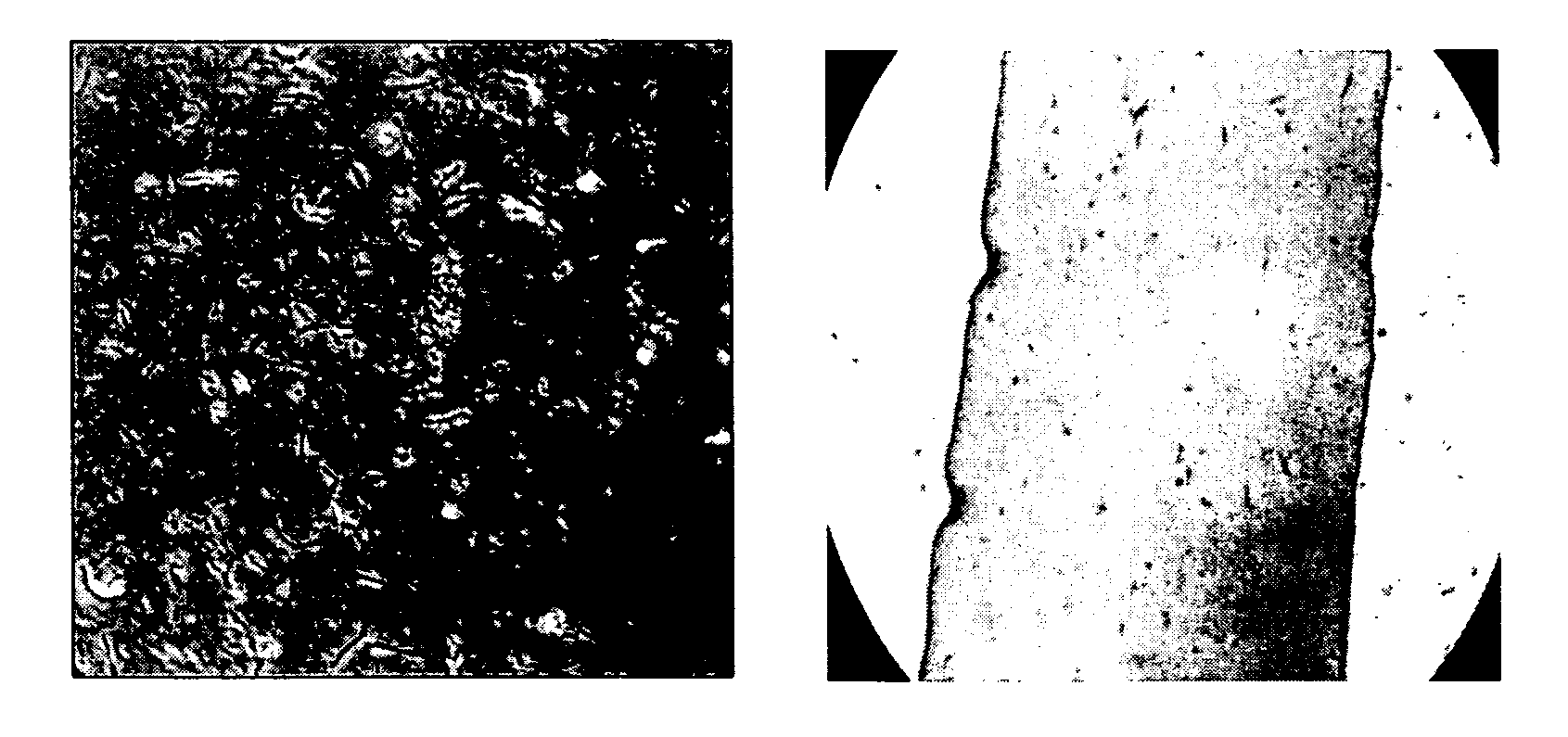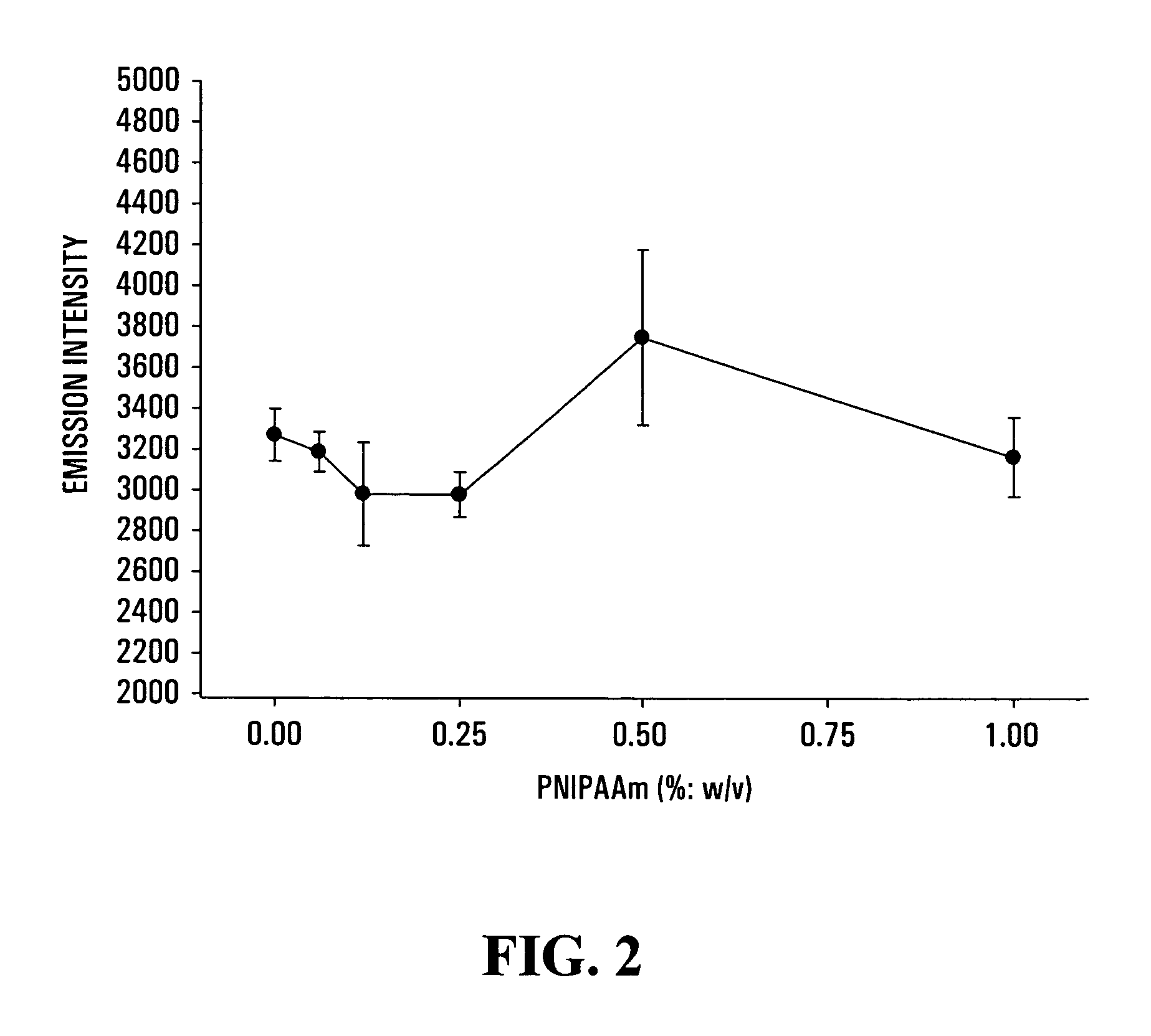Corneal implant and uses thereof
a technology of corneal implants and corneal blindness, applied in the field of corneal implants, can solve the problems of corneal blindness, corneal opacification, and subsequent impairment, and achieve the effect of poor success rate of the procedur
- Summary
- Abstract
- Description
- Claims
- Application Information
AI Technical Summary
Problems solved by technology
Method used
Image
Examples
example 1
Collagen-pNIPAAm Membranes
[0057]A sterile RTT collagen solution of 3.0-3.5 mg / ml (w / v) in acetic acid (0.02N in water) is made, and kept at 4° C. A 4% (w / v) solution of pNIPAAm homopolymer is made in water (ddH2O) and sterilized by autoclaving or by filtering (0.24tm). The 4% solution of pNIPAAm is diluted to a 1% solution with sterile ddH2O. The 0.30-0.35% solution of collagen and the 1% solution of pNIPAAm are mixed (1:1 vol / vol) in a sterile test tube at 4° C. by pumping with a pipette until well dispersed. Cold mixing will avoid any premature gelification or fibrillogenesis of the collagen during this procedure. Collagen-pNIPAAm is then poured into a plastic dish (non-treated culture dish) or a mold (e.g., lens or cornea mold) and left air-drying under sterile conditions in a laminar flow hood for at least 2-3 days at room temperature. After drying to constant weight (˜7% water residue) at room temperature, under laminar flow at relatively constant humidity, the formed membrane ...
example 2
Fibrin-pNIPAAm Membranes
[0059]A sterile fibrinogen (fraction I; type I-S from bovine plasma) solution (3 mg / ml in HBSS) is mixed with a 1% pNIPAAm solution as reported in Example 1. During mixing, thrombin (50 U / ml purchased from Parke Davis) is added at a final concentration of 0.03:1 v / v (thrombin:fibrin), and incubated for 10-15 min at 37° C. to allow gelification (hydrogel) in a culture well. This procedure strengthens the fibrin gel, probably by aiding the development of a filamentous network as shown on FIG. 1C.
example 3
Crosslinked Membranes
[0060]A sterile RTT collagen viscous solution and a 1% (w / v) solution of pNIPAAm are made as described in Example 1. The 0.30-0.35% solution of collagen and the 1% solution of pNIPAAm are mixed (1:1 vol / vol) with a 10% stock solution of 1-(3-dimethylaminopropyl)-3-ethyl carbodiimide hydrochloride (EDC) in water to give a final EDC concentration of 0.5; 0.1; or 0.05% (w / v) in a sterile test tube at 40° C. by pumping with a pipette until well dispersed. The collagen-pNIPAAm-EDC mixture is then poured into a plastic dish (non-treated culture dish) or a mold (e.g., lens or cornea molds) and left air-drying under sterile conditions in a laminar flow hood for at least 2-3 days at room temperature. After drying to constant weight (˜7% water residue), an interpenetrating network of pNIPAAm in cross-linked collagen is formed. Each membrane is removed from the mold after soaking in a sterile buffered solution (e.g., HBSS) at room temperature. Among the three different con...
PUM
| Property | Measurement | Unit |
|---|---|---|
| thickness | aaaaa | aaaaa |
| thickness | aaaaa | aaaaa |
| tensile energy to break | aaaaa | aaaaa |
Abstract
Description
Claims
Application Information
 Login to View More
Login to View More - R&D
- Intellectual Property
- Life Sciences
- Materials
- Tech Scout
- Unparalleled Data Quality
- Higher Quality Content
- 60% Fewer Hallucinations
Browse by: Latest US Patents, China's latest patents, Technical Efficacy Thesaurus, Application Domain, Technology Topic, Popular Technical Reports.
© 2025 PatSnap. All rights reserved.Legal|Privacy policy|Modern Slavery Act Transparency Statement|Sitemap|About US| Contact US: help@patsnap.com



